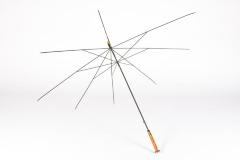Comments and Tags
Be the first to comment on this item!
Clothing and Accessories
Clothing Accessories
Women's Clothing ➔ Marquise Parasol
Identifier:
2011.42.9Description:
This marquise parasol has a black silk canopy with black lace overlay. The handle is made of painted black wood and features intricate carvings. A hinge can be seen at the midpoint of the shaft which allows the parasol to be folded in half. Parasols with this hinge were called carriage parasols and could be easily condensed in small spaces. There is another hinge under the canopy connected to the tip. This hinge is what classifies this parasol as a marquise parasol. It could be used to position the canopy to block the sun but its main purpose was for flirting. It was named after Madame de Pompadour, who invented it for the purpose of coquetry. This parasol is one of four clothing items that were donated to the Museum by the original owner's granddaughter. The items, a parasol, hat, cape and wedding dress all date from the late 1800s and early 1900s.Women often carried parasols to protect their complexion from the sun. A fair complexion was prized as a symbol of a life of leisure, showing that these women didn't have to work outside and could spend their days inside.
Date:
19th centuryMaterials:
Silk, Lace, Wood, MetalDimensions:
26.5"" h 17"" wCurrent Location Status:
In StorageCollection Tier:
Tier 2Source:
Gift Of Katherine And Robert KimballRelated Entities:
Katherine and Robert Kimball (donor) Hester Schravesande (used by)Hester Schravesande was born in 1897 in Bay City Michigan. She was married to John Belknap, a descendant of Charles Belknap. In 1973 she passed away in Grand Rapids, Michigan.
Belknap was best know as the founder of Belknap Wagon and Sleight Co. in the 1884. The company manufactured wagons, cart and sleighs and by 1890 employed over 50 men. Belknap was also a fire fighter, mayor of Grand Rapids in 1885 and served in many civic organizations throughout his life.


